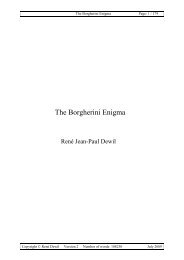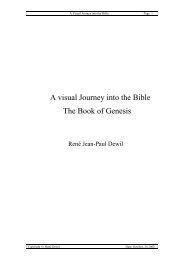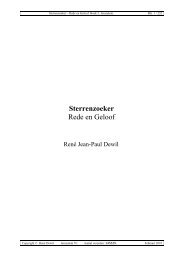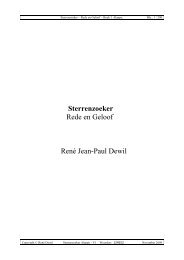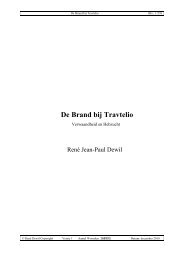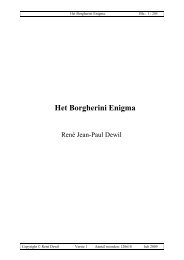A visual Journey into the Bible - Theartofpainting.be
A visual Journey into the Bible - Theartofpainting.be
A visual Journey into the Bible - Theartofpainting.be
- No tags were found...
You also want an ePaper? Increase the reach of your titles
YUMPU automatically turns print PDFs into web optimized ePapers that Google loves.
The Deuteronomy Page: 30 / 334When Jacopo Robusti painted <strong>the</strong> ‘Annunciation to Manoah’s Wife’ he was aboutforty years old and he had not yet delivered his most formidable work. He was stilllooking to gain not so much <strong>the</strong> admiration of Venice as her astonishment. His pictureis one of two paintings, painted both to Old Testament <strong>the</strong>mes. The o<strong>the</strong>r picture is <strong>the</strong>‘Meeting of Tamar and Judith’ and both pictures are now in <strong>the</strong> Thyssen-BornemiszaCollection in Madrid. The pictures have a very similar composition.In <strong>the</strong> ‘Annunciation’ we see Manoah’s Wife on <strong>the</strong> left, <strong>the</strong> angel on <strong>the</strong> right. Thecomposition is in a traditional ‘Open V’ and in <strong>the</strong> open space <strong>be</strong>tween <strong>the</strong> twofigures we remark a <strong>be</strong>autiful landscape, a sea with a port town. T<strong>into</strong>retto painted <strong>the</strong>angel and Manoah’s wife to <strong>the</strong> sides, even showing <strong>the</strong>m only partly. He did that to<strong>be</strong> able to show more of <strong>the</strong> landscape. Few painters would have dared to cut off partsof <strong>the</strong>ir main figures of a <strong>the</strong>me, but we may assume that <strong>the</strong> pieces of T<strong>into</strong>retto wereaimed primarily as decoration for a hall of a Venetian palace so that <strong>the</strong> decorativeview received most attention. T<strong>into</strong>retto was already a renowned artist who couldafford to use such a representation without <strong>be</strong>ing scolded at by his commissioners. Hewas also a painter who knew that his viewers would have no effort in imagining <strong>the</strong>whole figures. He knew that <strong>the</strong> power of imagination needed only to <strong>be</strong> stimulated alittle by hints of figures.The view of <strong>the</strong> landscape of T<strong>into</strong>retto is grand indeed. T<strong>into</strong>retto painted a darkgreen tree on <strong>the</strong> left and an ochre hillside on <strong>the</strong> right, still topped with a tree. Thelandscape view opens <strong>be</strong>tween <strong>the</strong>se two. Jacopo T<strong>into</strong>retto was mostly concentratedon <strong>the</strong> expression of his figures, so this painting of a landscape is remarkable in that itproved T<strong>into</strong>retto also to <strong>be</strong> a great landscape painter – if he only thought landscape to<strong>be</strong> important. He obtained an astonishing, epic view by having <strong>the</strong> sun throw straight,silvery lines over lake and town. The view is imaginary, and does not have much todo with a <strong>Bible</strong> story, but it is particularly striking. T<strong>into</strong>retto applied several differenthues of colour in <strong>the</strong> sky that lies heavily, laden with dark clouds over <strong>the</strong> view. Thehorizon is low and if <strong>the</strong> sky were not imposingly enough, T<strong>into</strong>retto added dark,massive hills – probably as he knew from <strong>the</strong> Venetian Alps – to <strong>the</strong> really flat andsmall town. We think of Naples, oppressed by its Vulcan, or of so many o<strong>the</strong>r smallItalian towns in bays of <strong>the</strong> Adriatic of <strong>the</strong> Mediterranean/ Look at <strong>the</strong> marvellousplay of light of <strong>the</strong> sunrays on <strong>the</strong> sea and on <strong>the</strong> clouds. The sea glows silvery and <strong>the</strong>sky is tainted yellow-orange with a richness of hues that reminds of Titian. The worksof man, its architecture, is large and grand when compared to man himself, but here<strong>the</strong> Roman columns of ancient temples remain very small in <strong>the</strong> grandeur of nature.T<strong>into</strong>retto borrowed elements from his illustrious competitors. He painted animals inhis picture. We see cows, deer and birds. Jacopo Bassano was famous for his picturesof scenes with many animals. Bassano’s paintings were much admired in Venice.T<strong>into</strong>retto seemed to have told with this painting of <strong>the</strong> ‘Annunciation’ that he wasJacopo Robusti, but that he could also paint animal scenes if he only put his mind andconsiderable professional skills to it. He could <strong>be</strong> equal to Jacopo Bassano when itcame to painting animals in landscapes.But of course, T<strong>into</strong>retto was T<strong>into</strong>retto. So he stayed committed to force of colour –with which he could equal Titian – and to bring <strong>the</strong> expression of emotionsspectacularly close to <strong>the</strong> viewer. The angel in his painting looks at <strong>the</strong> viewer andManoah’s wife bows ostentatiously with grace.Copyright: René Dewil Date: Octo<strong>be</strong>r 2001



